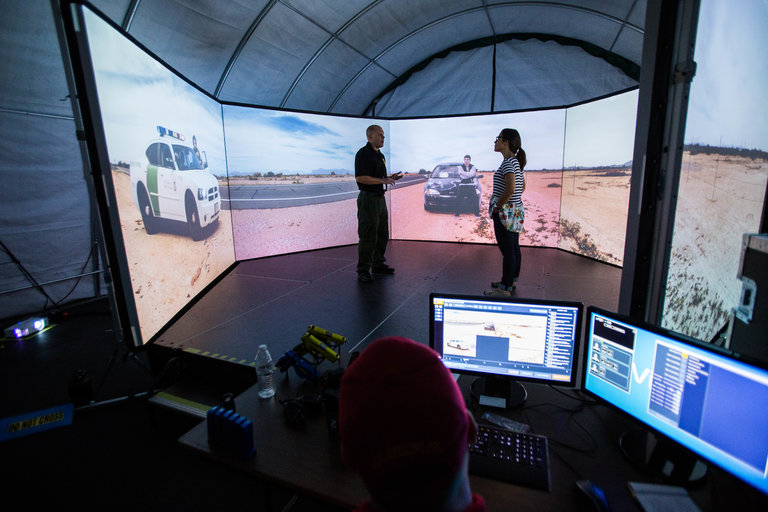
VirTra Interview with Dr. Paul O’Connell
VirTra works with a variety of consultants and academics in police and use of force training. Dr. Paul O’Connell is one of those experts. VirTra recently spoke with him about the history of use of force training, his experience in a VirTra V-300 system and his own personal training experience as a sworn officer in the New York City Police Department. This is the first in a two-part blog series.
What’s the current state of use of force training?
Use of force training has evolved dramatically over the last decade as more sophisticated technology became available, and high-profile cases such as the Michael Brown incident in Ferguson, Missouri brought increased media and public scrutiny to how departments train their officers. The ubiquity of mobile phone cameras has also played a role, making it almost a foregone conclusion that any confrontation that an officer has in public will be recorded or placed on social media.

VirTra V-300 offers a dynamic, virtual world training simulation that uses a variety of lethal and nonlethal weapons. Jason Daniels, an agent with the United States Border Patrol, instructing Fernanda Santos last week during a virtual reality exercise in Tucson. Credit Deanna Alejandra Dent for The New York Times
Law enforcement training has moved from officers standing motionless and shooting at static shooting ranges to a dynamic, virtual world that uses a variety of lethal and nonlethal weapons. The rules of engagement change instantaneously based on how an officer responds to the changes within a particular scenario. Despite these advancements, the recent shooting in Minnesota involving Justine Dramond shows that there are still issues with police training and how officers respond to potential threats, but the solutions are complex. Unfortunately, there are no simple answers.
What are some solutions that you do see?
Police chiefs might say that more training is the answer, but that’s what they’ve said for the last 40 years. What we need is a different type of training. Technology like Axon® TASERs® can help reduce physical confrontations, but officers also need to be prepared to handle situations by communicating effectively. They need to have the ability to “talk their way out of trouble.” In some of the post-incident debriefings I’ve been involved with in the past, younger officers who have reacted poorly said that they were afraid for their life. That might have been the case with the officer-involved shooting in Minneapolis.
Historically, how has law enforcement approached use of force training?
The history of tactical training for patrol officers is very weak, and can be traced back to when the “modern” police force first appeared in the 1840’s in Boston and New York. Police training was focused on marksmanship and “hitting the target,” and hand-to-hand combat was a different conversation altogether. The focus was not on the tactical or practical, but on proficiency, making sure the hit count was high in situations involving weapons discharge. Training like this was relatively unchanged until the period around World War II when an increased interest in more tactical training began to take hold.
By the 1970s most major police departments realized that they needed to structure their firearms training differently. Despite efforts like the FBI’s “Hogan’s Alley,” law enforcement training remained relatively unsophisticated up through the 1990s. Another shift took place when New York Mayor Giuliani began to pursue the idea of “community policing” in New York City at that time. We began to see training scenarios that encouraged trainees to avoid escalating a situation with drawn weapons. Trainees were coached to respond differently, to sometimes de-escalate and await backup.
When did the first viable form of interactive training appear?
The first real version of interactive use of force training appeared with the introduction of FireArms Training Systems about thirty years ago. This system was the first generation of interactive training simulators that used technology to help simulate a real-world environment for trainees. These simulators focused on marksmanship and an officer’s judgement.
However, this system had its drawbacks, in that it was a flat screen, and there was little that could be considered immersive. It was more game-like. Officers always knew they were using a video game-like machine in a police training facility, not really out on the streets. Officers couldn’t experience the same physical and mental sensations that they might feel in a field encounter. There was no adrenaline rush, no racing heartbeat – nothing to make it reality-based.
This system did allow agencies to have at least a rudimentary form of somewhat interactive judgmental simulation training without the associated costs of going to a range. A lot of agencies bought into the concept of this form of simulation training due to the cost savings it provided.
(Read part 2 of this Q&A next week)
About Paul O’Connell, Ph.D., J.D.:
Dr. O’Connell is a leading expert on the development and application of performance-based management systems in public agencies, and has provided consulting services to government agencies in twenty-six states, including assessment of their existing policing policies and practices. He has been a full-time member of the Criminal Justice faculty at Iona College in New Rochelle, NY since 1994, and he is the former Associate Dean of the School of Arts and Science and former chair of Iona College’s Criminal Justice Department. Dr. O’Connell is an attorney and a Senior Public Safety Consultant with the Center for Public Safety Management. He began his professional career in criminal justice in 1981, serving the New York City Police Department (NYPD) first as a police officer, and then as a Police Academy instructor, in-service trainer and curriculum developer. He is also the author of “Performance-Based Management for Police Organizations,” (Waveland 2007), and “Police Performance Appraisals: A Comparative Perspective.” (CRC Press 2012).





